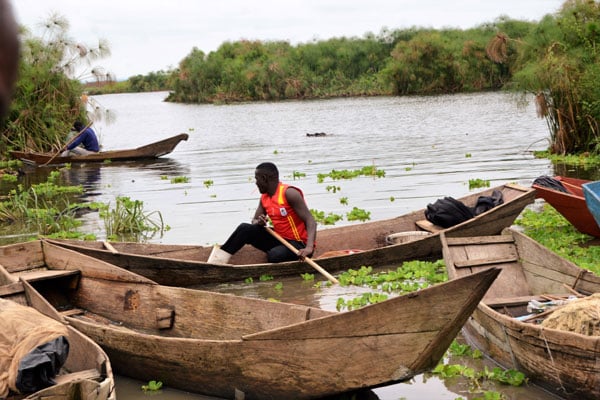Floating islands cut off fishermen on Lake Wamala

Fishermen at Butebi Landing Site in Mityana District, one of the areas which has been affected by the floating islands. PHOTO | BARBRA NALWEYISO
What you need to know:
- Travellers find it hard to sail through to Mityana and those on the lakeside in Kassanda and Mubende districts.
- Lake Wamala has 26 landing sites but 18 of them have been cut off by the sudds.
Fishermen on Lake Wamala in Mubende District have raised a red flag over the moving sudds (floating vegetation) which they claim is a threat to fishing communities and water transport.
Travellers find it hard to sail through to Mityana and those on the lakeside in Kassanda and Mubende districts.
Lake Wamala has 26 landing sites but 18 of them have been cut off by the sudds.
Many fishermen have been forced to relocate to safer landing sites such as Lusalira, Lubanja A and B in Mityana.
The most affected landing sites are Kyayi in Gomba,Bugolo, Bagwe in Kassanda, Wamala and Kampanzi (Mubende) and Katiko, Gombe and Butebi in Mityana.
Mr Ali Ssekiwunga, the chairperson of fishermen association around Lake Wamala, attributed the sudds to the rising water levels.
“When the water levels rise, they force the huge mass on the shores to break off, developing into small floating islands. The floating islands sometimes cause water accidents,” he said on Monday.
Mr Emmanuel Jjuuko Kamya , a resident of Katiko, said sometimes when they take a certain direction on the lake, they return when the known navigation route has been blocked.
“In such situations , we end up taking a longer route, which usually consumes fuel and time ,” he said.
Mr Yasin Bbira, the Mityana natural resource officer, said they do not have funds to remove the sudds.
“I appeal to all lake users, especially the fishers to always follow the direction of the wind to avoid water accidents since the suds are moved by the wind,” Mr Bbira said.
He said the long term solution is to dredge the lake and remove the floating vegetation to levels that do not pause any negative environmental and socio-economic impact.
Mr Bbira said the sudds offer good breeding grounds for fish.
“The sudds are preventing unscrupulous fishermen from catching immature fish since they run and hide underneath. When the sudds move away, the fishermen usually catch big fish from the place where it had staged,” he said.
Mr Bbira said they would petition the line ministry to remove the sudds.
Efforts to speak to the commissioner of aquaculture at the Ministry of Agriculture, Animal Industry and Fisheries, Ms Joyce Ikwaput Nyeko, were futile as our repeated calls to her known telephone went unanswered.
The State Minister for Fisheries,Ms Hellen Adoa’s known telephone was also switched off by press time.
When huge floating sudds invaded Lake Victoria last year and threatened electricity generation at Nalubale Hydro Power Station in Jinja, government used heavy machines such as long arm excavators, barges, a ferry, hydraulic crane, self-loading trucks, dump trucks and bulldozers to clear the heavy-moving islands.
The Uganda National Meteorological Authority on Monday advised those intending to travel to different islands on Lake Victoria to postpone their trips as weather radars show threatening thunderstorms on the lake.
Fishing on Lake Wamala
A report by Fish Stock Assessment Team, which was commissioned by National Fisheries Resources Research Institute (NaFIRRI) in 2012, states that Lake Wamala has 26 gazetted landing sites and about 600 fishermen with a similar number of boats.
A total of 16 landing sites are in Mityana while Gomba and Mubende have five landing sites each.
The report says the lake has poor socio-economic infrastructure compared to other lakes in Uganda probably due to its geo-morphological setting.
Available records indicate that fishermen use gillnets targeting the tilapia (Ngege) and long line hooks which trap Mamba (protperus) and, Male (Clarias).
The report also shows that 97 per cent of the gill nets on the lake are small stretched mesh size; while 98 per cent of the hoots are large.




